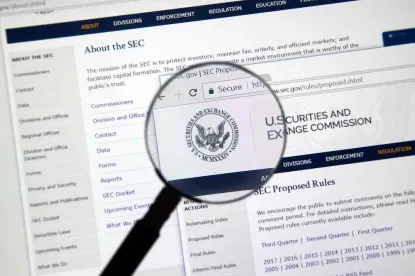The U.S. Securities and Exchange Commission (SEC) adopted amendments to its exempt offering framework with the purpose of promoting capital formation, as well as expanding investment opportunities for both accredited and non-accredited investors. For companies considering an exempt offering, the amendments are intended to make the following improvements:
-
Facilitate offering communications by permitting certain “test-the-waters” and “demo day” communications
-
Increase the offering limits for offerings under Regulation A, Rule 504 and Regulation Crowdfunding
-
Revise the investment limits for accredited and non-accredited investors in Regulation Crowdfunding offerings
-
Reduce the disclosure burden for Rule 506(b) offerings (private placements involving no general solicitation or advertising) that include non-accredited investors
-
Remove or reduce the compliance burden related to certain complex or difficult rules governing Regulation A offerings
-
Simplify the process for verifying whether certain repeat investors are accredited in a Rule 506(c) offering (private placements that may involve general solicitation or advertising)
-
Clarify whether multiple securities transactions by an issuer should be considered part of the same offering for purposes of determining compliance
These amendments should also be considered along with the SEC’s earlier amendments to the definition of accredited investor, which were intended to expand the number of individuals and entities that qualify as accredited investors.
The amendments discussed in this article will be effective 60 days after publication in the Federal Register.
GENERAL SOLICITATION AND OFFERING COMMUNICATION
The SEC amended the offering communication rules to permit certain “demo day” and “test-the-waters” communications.
“Demo day” events
Under the amendments, certain “demo day” communications will not be deemed general solicitation or general advertising, including certain communications made in connection with a seminar or meeting sponsored by a college, university or other institution of higher education, a state or local government or instrumentality of a state or local government, a nonprofit organization, or an angel investor group, incubator or accelerator.
“Test-the-waters” communications
The amended rules allow the opportunity for issuers to ascertain interest in an exempt offering prior to incurring the full expense of preparing and conducting the offering. In particular, the SEC adopted amendments that permit an issuer to use generic solicitation of interest materials to “test-the-waters” for an exempt offer of securities prior to a making a determination as to the exemption under which the offering will be conducted. The amended rule contains certain filing requirements, including a requirement that generic solicitation materials be made publicly available as an exhibit to the offering materials filed with the SEC for offerings under Regulation A and Regulation Crowdfunding.
Before participating in a “demo day” event or engaging in “test-the-waters” communications, issuers should consult with counsel, as the SEC’s rules, as well as state securities laws, contain several additional limitations and conditions.
Offering and investment limits
The SEC also amended the offering and investment limits for exempt private offerings, as set forth in the following chart:
|
Regulation A |
Rule 504 |
Regulation Crowdfunding |
|
Offering limits:
|
Offering limit: Raise the maximum offering amount from $5 million to $10 million |
Offering limit:
Investment limit:
|
RULE 506(B) OFFERING HARMONIZATION OF DISCLOSURE REQUIREMENTS
Rule 506(b) permits an offering to an unlimited number of accredited investors, as well as 35 sophisticated but non-accredited investors. However, non-reporting issuers are required to provide audited financial statements if the offering includes non-accredited investors. The SEC noted that some issuers have viewed this disclosure requirement as overly burdensome and, as a result, have avoided including non-accredited investors in such offerings. Accordingly, the SEC revised the disclosure requirement to, in part, remove the requirement to provide audited financial statements for offerings under $20 million.
While this revision may make issuers more willing to include non-accredited investors in their offerings, it should also be noted that offerings under Rule 506(b) that include non-accredited investors are still subject to heightened non-financial disclosure obligations which, for some issuers, will likely outweigh the benefits of offering to those investors. Any issuers considering including non-accredited investors in an offering under Rule 506(b) should consult with counsel to understand the obligations and potential risks associated with doing so.
Regulation A
The SEC noted that there are several areas where compliance with Regulation A is more complex or difficult than registered offerings. Accordingly, the SEC simplified the rules regarding the redaction of confidential information in material contracts, making draft offering statements public on EDGAR, incorporating by reference, and the abandonment of a post-qualification amendment.
RULE 506(C) ACCREDITED INVESTOR VERIFICATION REQUIREMENTS
Rule 506(c) permits an issuer to solicit and advertise an offering if all the purchasers are accredited investors and the issuer takes specific reasonable, affirmative steps to verify that purchasers are accredited, subject to a variety of conditions. The newly adopted rules are intended to make this process easier for issuers selling to repeat investors. In particular, if an issuer previously took reasonable steps to verify an investor as accredited, then the issuer may establish that the investor remains accredited based on a written representation from the investor to that effect, subject to a five-year limitation, as long as the issuer is not aware of information to the contrary.
INTEGRATION FRAMEWORK
The SEC and its staff have developed a body of rules and guidance for determining whether multiple securities transactions by an issuer should be considered part of the same offering, which has grown increasingly complex as the number of exemptions from registration available to issuers has evolved. Accordingly, when issuers use various private offering exemptions, questions often arise as to whether the offerings should be integrated and as to whether the offerings comply with applicable limitations and conditions.
The SEC amendments set forth a comprehensive integration framework composed of four safe harbors applicable to all securities offerings under the Securities Act of 1933, as well as a general principle of integration for situations to which the safe harbors do not apply.
In summary, the safe harbors are as follows:
-
Any offering made more than 30 calendar days before the commencement of any other offering, or more than 30 calendar days after the termination or completion of any other offering, will not be integrated with such other offering, provided that for an offering under Rule 506(b) for which general solicitation is not permitted that follows by 30 calendar days or more an offering under Rule 506(c) that allows general solicitation, the general principle of integration will apply;
-
Offers under a compensatory benefit plan in accordance with Rule 701 or offshore offerings under Regulation S will not be integrated with other offerings, consistent with the existing provisions of those regulations;
-
An offering for which a registration statement has been filed with the SEC will not be integrated if it is made subsequent to (1) a terminated or completed offering for which general solicitation is not permitted, (2) a terminated or completed offering under Rule 506(c) made only to qualified institutional buyers or institutional accredited investors, or (3) an offering under Rule 506(c) that terminated or completed more than 30 calendar days prior to the commencement of the registered offering; and
-
Offers and sales under Rule 506(c) will not be integrated if made subsequent to any terminated or completed offering.
Because of the complexities of the integration framework, issuers conducting multiple offerings in parallel or in close time proximity should consult with counsel to determine whether those offerings may be integrated.
OTHER AMENDMENTS
Regulation Crowdfunding and Regulation A eligibility
The SEC amended Regulation Crowdfunding to permit the use of certain special purpose vehicles as a conduit for investors, which is intended to facilitate investing in Regulation Crowdfunding issuers. In connection with Regulation A, the SEC amendments impose eligibility restrictions on the use of Regulation A by issuers that are delinquent in reporting obligations under the Securities Exchange Act of 1934.
Bad actor disqualification provisions
The exempt offering framework includes rules disqualifying certain covered persons, including felons and other “bad actors,” from relying on Regulation A, Regulation Crowdfunding and Regulation D to offer and sell securities. The SEC adopted rules to harmonize the bad actor disqualifications to use the same lookback period, which looks to both the time of filing of the offering document and the time of sale.




 />i
/>i

